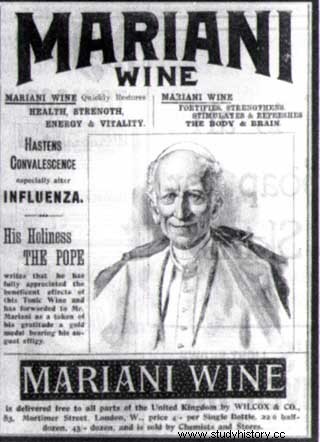According to the version of Coca-Cola itself , the history of the most popular soft drink began on May 8, 1886 in Atlanta and, therefore, is very American. Pharmacist John S. Pemberton he wanted to create a syrup against digestion problems that would also provide energy, and he ended up finding the most famous secret formula in the world. Jacobs Pharmacy was the first to market the drink at a price of 5 cents a glass, selling about nine each day. It was just the beginning of a history of more than 120 years.

Pemberton soon realized that the drink he had created could be a hit. His accountant, Frank Robinson , was the one who devised the brand and designed the logo:Coca-Cola was born. The Coca-Cola Company was founded in 1891 and two years later they registered the trademark with the United States Industrial Property Registry Office.

John S. Pemberton
Possible alternative origins
In 1863 the French chemist Angelo Mariani , after investigating the work of the Italian scientist Paolo Mantegazza about the effects of coca on the human psyche, he marketed a new product: a wine called Vin Mariani , Bordeaux wine treated with coca leaf extract. That tonic, which contained 6 mg of coca per fluid ounce of wine, became very popular in Europe and when, years later, it began to be exported to the United States, its coca content was increased to 7.2 mg to compete with the concoction by John Pemberton. The success of the new concoction was resounding, counting among its usual consumers characters such as Queen Victoria of England, Tsar Alexander II, writers such as Jules Verne or Emile Zola... and even Pope Leo XIII. It was said that the Pope was always accompanied by a flask of this peculiar tonic; the Vatican even awarded him the gold medal. Angelo, who was a business lynx, took advantage of the audience with the Pope, on the occasion of the delivery of the medal, and requested permission to use his image in an advertising campaign. He has been the only Pope in all of history who has lent himself to it.

In 2013 the German magazine Der Spiegel echoed the claim of the businessman Juan Micó which placed the origin of the soft drink in the town of Aielo de Malferit (Valencia Spain). Micó assures that the American multinational did nothing more than copy the formula of the “Kola Coca ”, a liqueur made since 1880 at the Aielo Liquor Factory. The name of this concoction was due to the fact that kola nuts were used in its preparation, the fruit of some species of African trees with a high content of caffeine, and coca leaf extract from Peru.
And how did the formula get to the US?
Bautista Aparici , one of the founders of the factory, traveled with his liquor to different trade fairs in Europe and the US, being recognized with several awards:Milan (1881), Chicago (1883), Philadelphia (1885), London (1889) and Paris ( 1900). When in 1885 he moved to the Philadelphia fair, Aparici, after collecting the prize, gave some samples of his star product to some American sales representatives. Maybe it was a coincidence, maybe not, but just a year later pharmacist John Pemberton made history when he invented Coca-Cola. When Coca-Cola put its tentacles in the Spanish market, back in 1953, they had to reach an agreement with the small factory in Aielo and buy the patent registered in 1903. For an amount, the exact amount of which was never known, Coca-Cola Cola got rid of a problem and the Spanish factory began to manufacture the alcoholic version called “Nuez de Kola Coca ”.
And, to finish, we will look for its origin in Bolivia. In 1867, a love story or, rather, heartbreak, led the Italian pharmacist Domenico Lorini to La Paz (Bolivia). While Domenico was fighting in Italy for unification, his girlfriend, believing him dead after being wounded in combat, decided to marry someone else. When Domenico returned, and given the decision that his girlfriend had made, he put land and sea in between and accepted a job offer from an Italian pharmaceutical laboratory based in La Paz. It didn't take long for Domenico to realize the therapeutic effects offered by the coca leaf, so widely used in those parts for concoctions, plasters or directly chewed. For this reason, he began to work from the laboratory of the " Botica Italiana “ studying the characteristics and properties of the plant. In the end, after a long process of experimentation, Domenico launched the “Elixir de Coca Lorini ” as restorative and invigorating, in addition to relieving respiratory and stomach problems.
What happened to Domenico Lorini's formula?
While Lorini continued to research and work with derivatives of the coca leaf, his concoction began to be exported, coincidentally, to the United States and France. At the end of the 19th century, the patent was sold to the American laboratories Parke Davis , who took advantage of the formula to create his own syrup and, according to the descendants of Lorini,…
Coca Cola began to make the soft drink based on Parke Davis syrup. It must have had a nice flavor and other ingredients were added.
Now, let each one keep the story they like the most.

Article published in the @iHstoria magazine of Mediazines.
